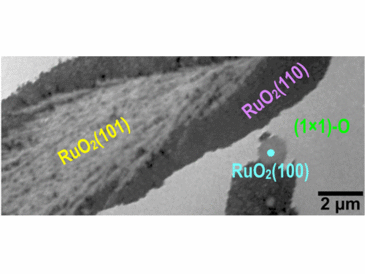Jan Ingo Flege, Benjamin Herd, Jan Goritzka, Herbert Over, Eugene E. Krasovskii and Jens Falta.
ACS Nano (2015) 9, 8468-8473.
The structural modification of the Ru(0001) surface is followed in real-time using low-energy electron microscopy at elevated temperatures during exposure to molecular oxygen. We observe the nucleation and growth of three different RuO2 facets, which are unambiguously identified by single-domain microspot low-energy electron diffraction (mu LEED) analysis from regions of 250 nm in diameter. Structural identification is then pushed to the true nanoscale by employing very-low-energy electron reflectivity spectra R(E) from regions down to 10 nm for structural fingerprinting of complex reactions such as the oxidation of metal surfaces. Calculations of R(E) with an ab initio scattering theory confirm the growth of (110), (100), and (101) orientations of RuO2 and explain the shape of the R(E) spectra in terms of the conducting band structure. This methodology is ideally suited to identify the structure of supported ultrathin films and dynamic transformations at multicomponent interfaces down to few nanometer lateral resolution at elevated temperature and in reactive environments.


